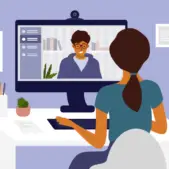Accessibility is no longer a “nice-to-have”. It’s a critical, non-negotiable element of creating digital experiences that work for everyone. True accessibility design ensures that websites, mobile apps, and digital tools are usable, understandable, and enjoyable for people of all abilities; including those with disabilities, visual or hearing impairments, cognitive challenges, or diverse device needs.
Beyond serving people with disabilities, accessibility design also accounts for:
- Different screen sizes and device types
- Variable internet speeds
- Temporary impairments (like a broken arm or eye strain)
- Cultural differences in content understanding
By optimizing the digital experience for everybody, businesses unlock new avenues for engagement, growth, and impact, and meet evolving legal and ethical expectations in the digital landscape.
In this article, we explore key principles and best practices for modern accessibility design, along with strategies to build inclusive experiences that empower all users to engage, explore, and convert.

Why Poor Accessibility Breaks User Experience
Let’s ground this in a real-world example: Imagine a government website intended to help senior citizens access retirement benefits.
- The font is small and dense.
- Navigation options are vague and confusing.
- The color contrast is poor, and action buttons blend into the background.
Senior citizens, often grappling with lower tech familiarity and diminished vision, encounter immediate friction. They struggle to find basic information, leading to frustration, abandonment, or costly support calls. When accessibility is overlooked, it doesn’t just exclude users, it undermines trust, satisfaction, and outcomes for everyone.
Accessibility Design Aesthetics
Modern accessibility design addresses diverse user needs by applying thoughtful, proactive principles, including:
1. Visual Accessibility
- Use scalable font sizes and ensure text remains readable across devices.
- Break up large blocks of text into smaller, digestible sections.
- Ensure high color contrast between text and background (following WCAG contrast ratios).
- Avoid using color alone to convey meaning — use patterns, labels, or icons for reinforcement.
2. Cognitive and Reading Accessibility
- Simplify content with clear, plain language.
- Use consistent layouts and predictable navigation patterns.
- Offer multiple ways to access information (text, visuals, video).
- Break complex processes into smaller, guided steps.
3. Multimedia Accessibility
- Provide captions for all video content.
- Offer transcripts for audio content.
- Where possible, design videos with visual storytelling that doesn’t rely solely on dialogue.
4. Device and Platform Inclusivity
- Implement responsive design to optimize content for any screen size or orientation.
- Design accessible mobile apps with large, tappable targets and minimal clutter.
- Offer vibration alerts or haptic feedback where appropriate for notifications.
- Support text-to-speech compatibility for visually impaired or multitasking users.
5. Keyboard and Screen Reader Support
- Ensure all content and functionality is accessible via keyboard (no mouse required).
- Use semantic HTML to create logical page structures for screen readers.
- Include clear focus indicators (visual highlights) for active links and form fields.
- Add ARIA landmarks where necessary to define sections of your site for assistive technology.
Modern Accessibility Testing Strategies
Accessibility isn’t achieved by good intentions alone — it requires continuous testing and iteration.
Today’s best practices include:
- Automated audits using tools like Axe, WAVE, or Lighthouse.
- Manual keyboard testing to ensure no trap zones exist.
- Screen reader testing (e.g., NVDA, VoiceOver, TalkBack) to validate navigation flows.
- User testing with diverse participants, including people with disabilities, to gather authentic feedback.
Accessibility testing should be embedded into every design and development sprint, not reserved for a final QA checklist.
Beyond Compliance: Building an Inclusive Digital Future
Following accessibility guidelines such as WCAG 2.1 and 2.2 isn’t just about ticking a compliance box.
It’s about:
- Expanding your reach to millions of users who rely on accessible design
- Strengthening brand reputation through inclusivity
- Reducing legal risk under standards like ADA, Section 508, and EN 301 549
- Building experiences that are better for everyone, not just a subset of users
When digital accessibility is prioritized, organizations foster loyalty, trust, and growth, while contributing to a more equitable digital landscape.
Partnering to Build Inclusive Digital Experiences
At UpTop, accessibility is woven into every UX strategy, design decision, and development process.
We offer:
- Accessibility audits aligned with WCAG guidelines
- UX research with inclusive participant panels
- Design and content strategies optimized for real-world accessibility
- Recommendations for sustainable accessibility practices over time
Ready to expand your reach and build more inclusive digital experiences? Let’s connect. Together, we can unlock opportunities for every user.


